COMR2010 - Reflective Essay: Exploring Dimensions of Culture
VerifiedAdded on 2022/11/28
|7
|1616
|129
Journal and Reflective Writing
AI Summary
This essay explores the concept of culture, defining it as a shared behavior pattern within a group, encompassing language, religion, social habits, and norms. The author discusses how culture is both learned and inherited, influencing individual behaviors and social patterns. The essay then delves into Geert Hofstede's cultural dimension theory, a framework for understanding cultural differences, and explains its key dimensions: power distance, individualism versus collectivism, uncertainty avoidance, masculinity versus femininity, and long-term versus short-term orientation. The author provides a personal reflection on adapting to a new culture, highlighting the challenges and learning experiences encountered while studying abroad. The essay concludes by emphasizing the unique nature of each culture and the importance of adapting to new ideas and lifestyles.
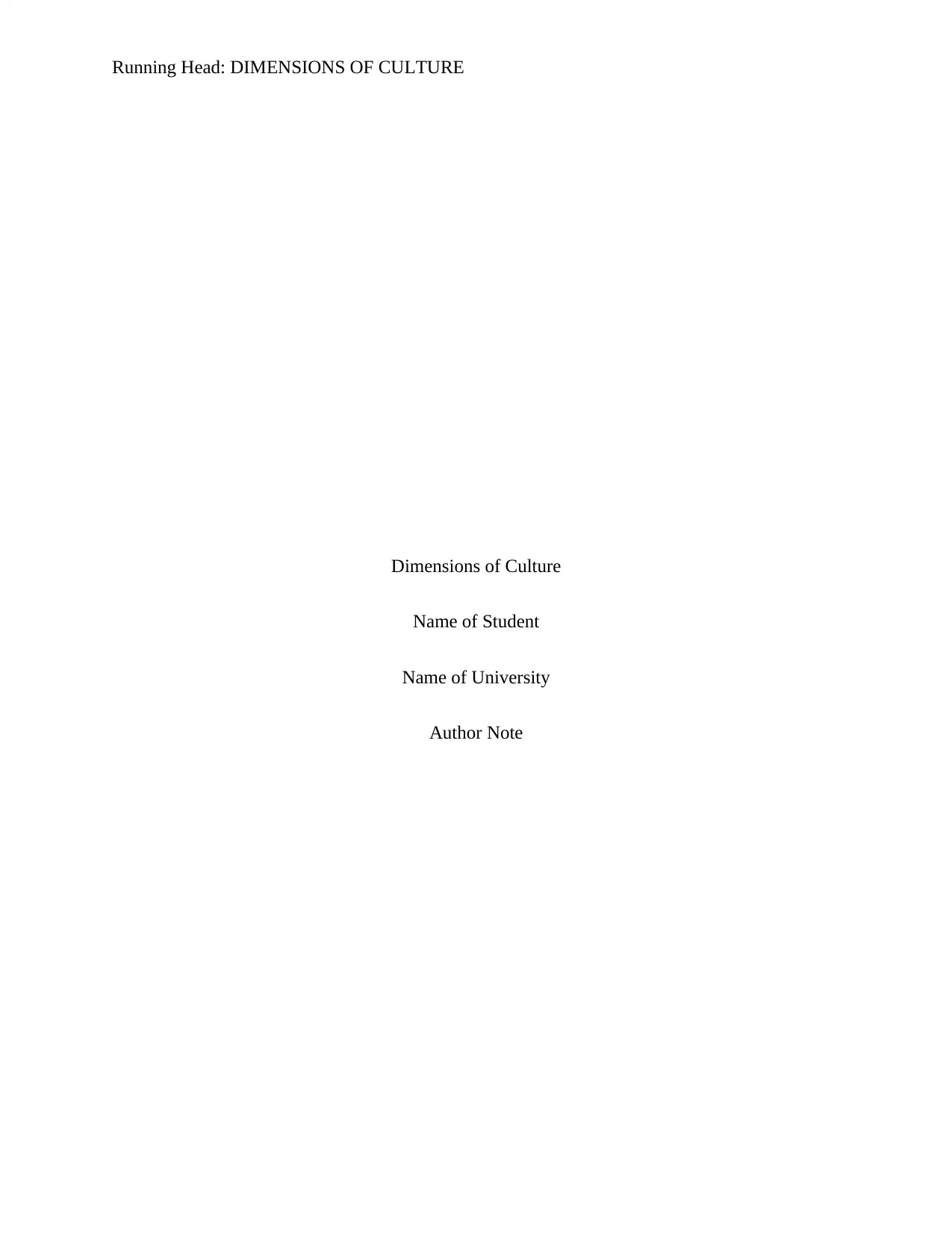
Running Head: DIMENSIONS OF CULTURE
Dimensions of Culture
Name of Student
Name of University
Author Note
Dimensions of Culture
Name of Student
Name of University
Author Note
Paraphrase This Document
Need a fresh take? Get an instant paraphrase of this document with our AI Paraphraser
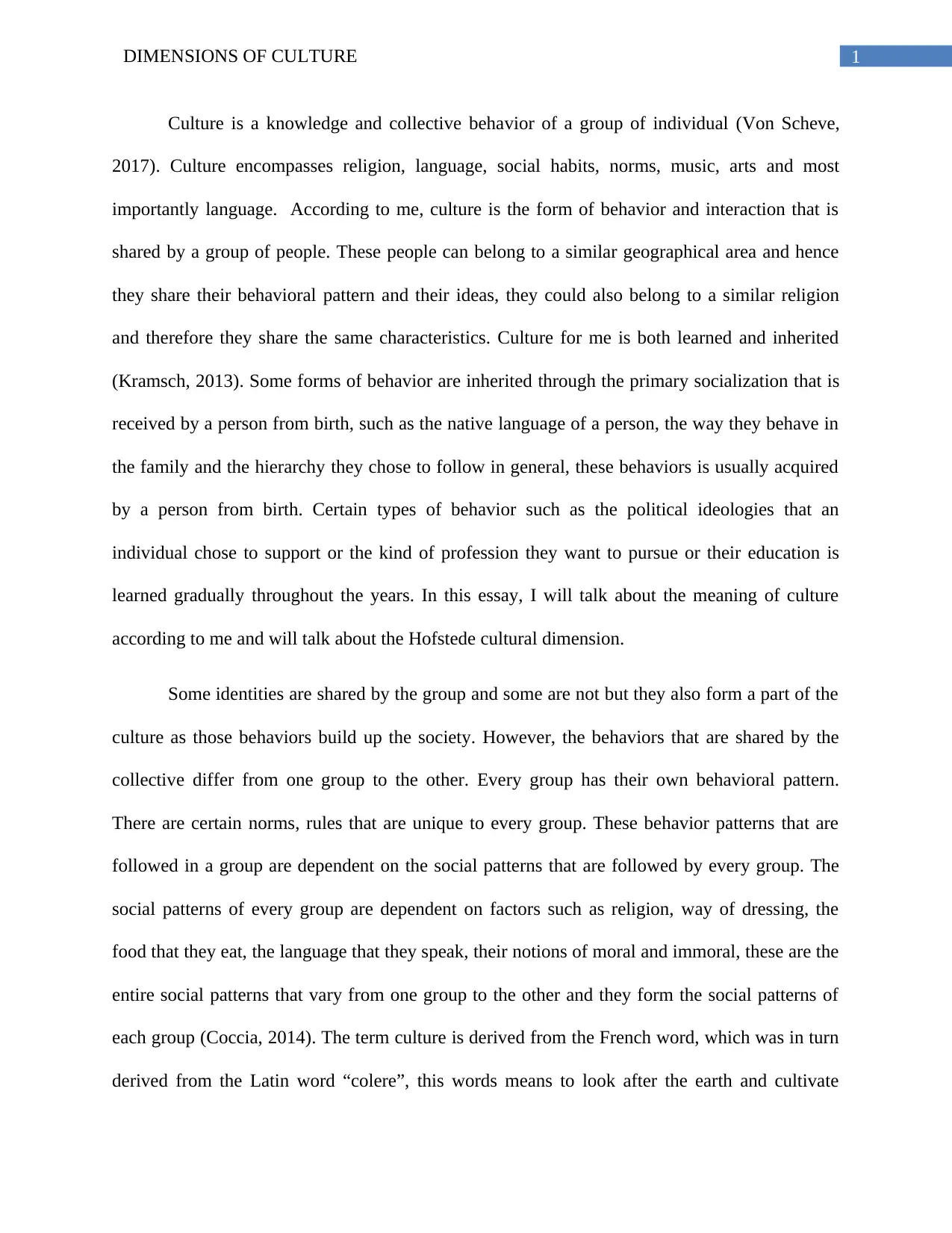
1DIMENSIONS OF CULTURE
Culture is a knowledge and collective behavior of a group of individual (Von Scheve,
2017). Culture encompasses religion, language, social habits, norms, music, arts and most
importantly language. According to me, culture is the form of behavior and interaction that is
shared by a group of people. These people can belong to a similar geographical area and hence
they share their behavioral pattern and their ideas, they could also belong to a similar religion
and therefore they share the same characteristics. Culture for me is both learned and inherited
(Kramsch, 2013). Some forms of behavior are inherited through the primary socialization that is
received by a person from birth, such as the native language of a person, the way they behave in
the family and the hierarchy they chose to follow in general, these behaviors is usually acquired
by a person from birth. Certain types of behavior such as the political ideologies that an
individual chose to support or the kind of profession they want to pursue or their education is
learned gradually throughout the years. In this essay, I will talk about the meaning of culture
according to me and will talk about the Hofstede cultural dimension.
Some identities are shared by the group and some are not but they also form a part of the
culture as those behaviors build up the society. However, the behaviors that are shared by the
collective differ from one group to the other. Every group has their own behavioral pattern.
There are certain norms, rules that are unique to every group. These behavior patterns that are
followed in a group are dependent on the social patterns that are followed by every group. The
social patterns of every group are dependent on factors such as religion, way of dressing, the
food that they eat, the language that they speak, their notions of moral and immoral, these are the
entire social patterns that vary from one group to the other and they form the social patterns of
each group (Coccia, 2014). The term culture is derived from the French word, which was in turn
derived from the Latin word “colere”, this words means to look after the earth and cultivate
Culture is a knowledge and collective behavior of a group of individual (Von Scheve,
2017). Culture encompasses religion, language, social habits, norms, music, arts and most
importantly language. According to me, culture is the form of behavior and interaction that is
shared by a group of people. These people can belong to a similar geographical area and hence
they share their behavioral pattern and their ideas, they could also belong to a similar religion
and therefore they share the same characteristics. Culture for me is both learned and inherited
(Kramsch, 2013). Some forms of behavior are inherited through the primary socialization that is
received by a person from birth, such as the native language of a person, the way they behave in
the family and the hierarchy they chose to follow in general, these behaviors is usually acquired
by a person from birth. Certain types of behavior such as the political ideologies that an
individual chose to support or the kind of profession they want to pursue or their education is
learned gradually throughout the years. In this essay, I will talk about the meaning of culture
according to me and will talk about the Hofstede cultural dimension.
Some identities are shared by the group and some are not but they also form a part of the
culture as those behaviors build up the society. However, the behaviors that are shared by the
collective differ from one group to the other. Every group has their own behavioral pattern.
There are certain norms, rules that are unique to every group. These behavior patterns that are
followed in a group are dependent on the social patterns that are followed by every group. The
social patterns of every group are dependent on factors such as religion, way of dressing, the
food that they eat, the language that they speak, their notions of moral and immoral, these are the
entire social patterns that vary from one group to the other and they form the social patterns of
each group (Coccia, 2014). The term culture is derived from the French word, which was in turn
derived from the Latin word “colere”, this words means to look after the earth and cultivate
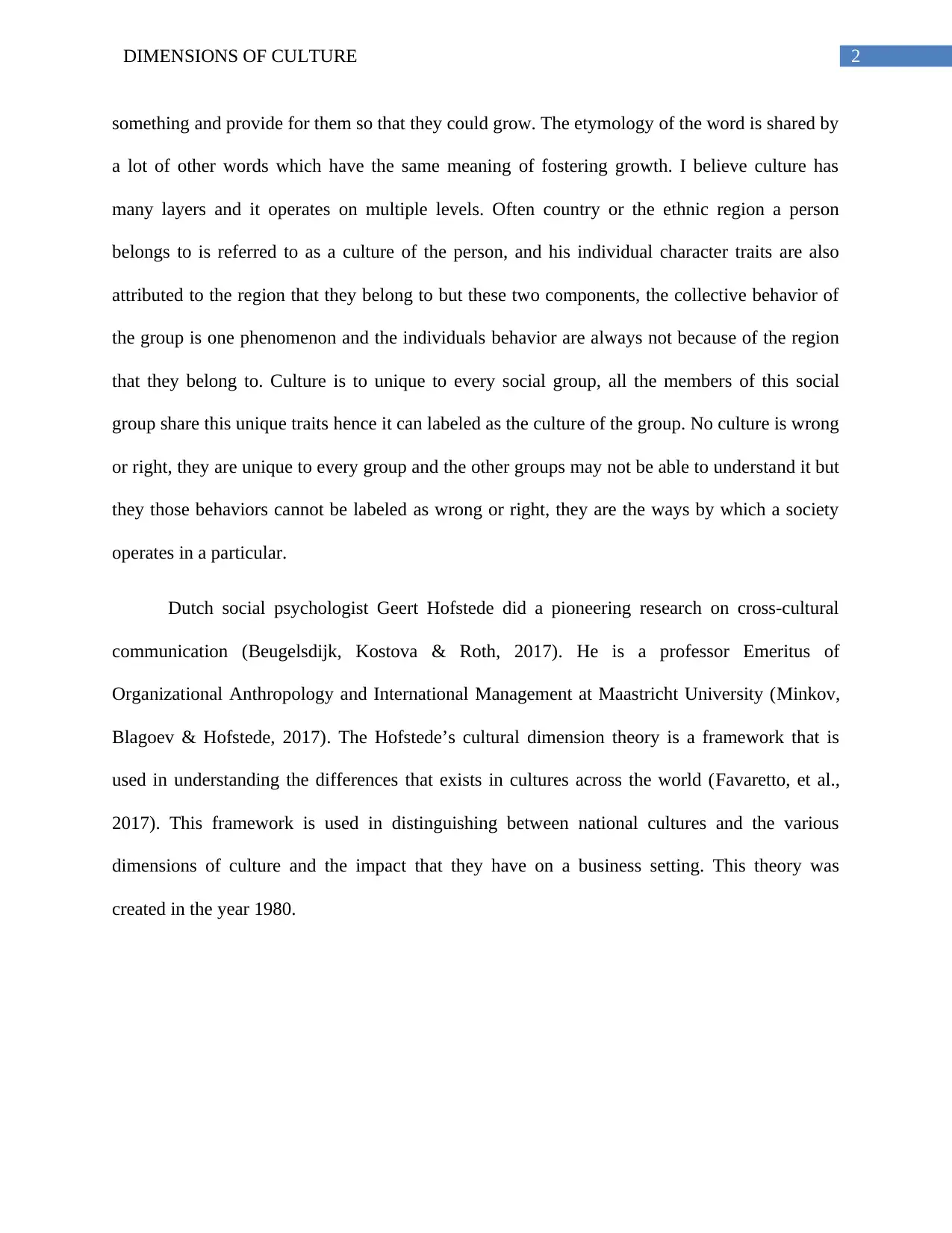
2DIMENSIONS OF CULTURE
something and provide for them so that they could grow. The etymology of the word is shared by
a lot of other words which have the same meaning of fostering growth. I believe culture has
many layers and it operates on multiple levels. Often country or the ethnic region a person
belongs to is referred to as a culture of the person, and his individual character traits are also
attributed to the region that they belong to but these two components, the collective behavior of
the group is one phenomenon and the individuals behavior are always not because of the region
that they belong to. Culture is to unique to every social group, all the members of this social
group share this unique traits hence it can labeled as the culture of the group. No culture is wrong
or right, they are unique to every group and the other groups may not be able to understand it but
they those behaviors cannot be labeled as wrong or right, they are the ways by which a society
operates in a particular.
Dutch social psychologist Geert Hofstede did a pioneering research on cross-cultural
communication (Beugelsdijk, Kostova & Roth, 2017). He is a professor Emeritus of
Organizational Anthropology and International Management at Maastricht University (Minkov,
Blagoev & Hofstede, 2017). The Hofstede’s cultural dimension theory is a framework that is
used in understanding the differences that exists in cultures across the world (Favaretto, et al.,
2017). This framework is used in distinguishing between national cultures and the various
dimensions of culture and the impact that they have on a business setting. This theory was
created in the year 1980.
something and provide for them so that they could grow. The etymology of the word is shared by
a lot of other words which have the same meaning of fostering growth. I believe culture has
many layers and it operates on multiple levels. Often country or the ethnic region a person
belongs to is referred to as a culture of the person, and his individual character traits are also
attributed to the region that they belong to but these two components, the collective behavior of
the group is one phenomenon and the individuals behavior are always not because of the region
that they belong to. Culture is to unique to every social group, all the members of this social
group share this unique traits hence it can labeled as the culture of the group. No culture is wrong
or right, they are unique to every group and the other groups may not be able to understand it but
they those behaviors cannot be labeled as wrong or right, they are the ways by which a society
operates in a particular.
Dutch social psychologist Geert Hofstede did a pioneering research on cross-cultural
communication (Beugelsdijk, Kostova & Roth, 2017). He is a professor Emeritus of
Organizational Anthropology and International Management at Maastricht University (Minkov,
Blagoev & Hofstede, 2017). The Hofstede’s cultural dimension theory is a framework that is
used in understanding the differences that exists in cultures across the world (Favaretto, et al.,
2017). This framework is used in distinguishing between national cultures and the various
dimensions of culture and the impact that they have on a business setting. This theory was
created in the year 1980.
⊘ This is a preview!⊘
Do you want full access?
Subscribe today to unlock all pages.

Trusted by 1+ million students worldwide
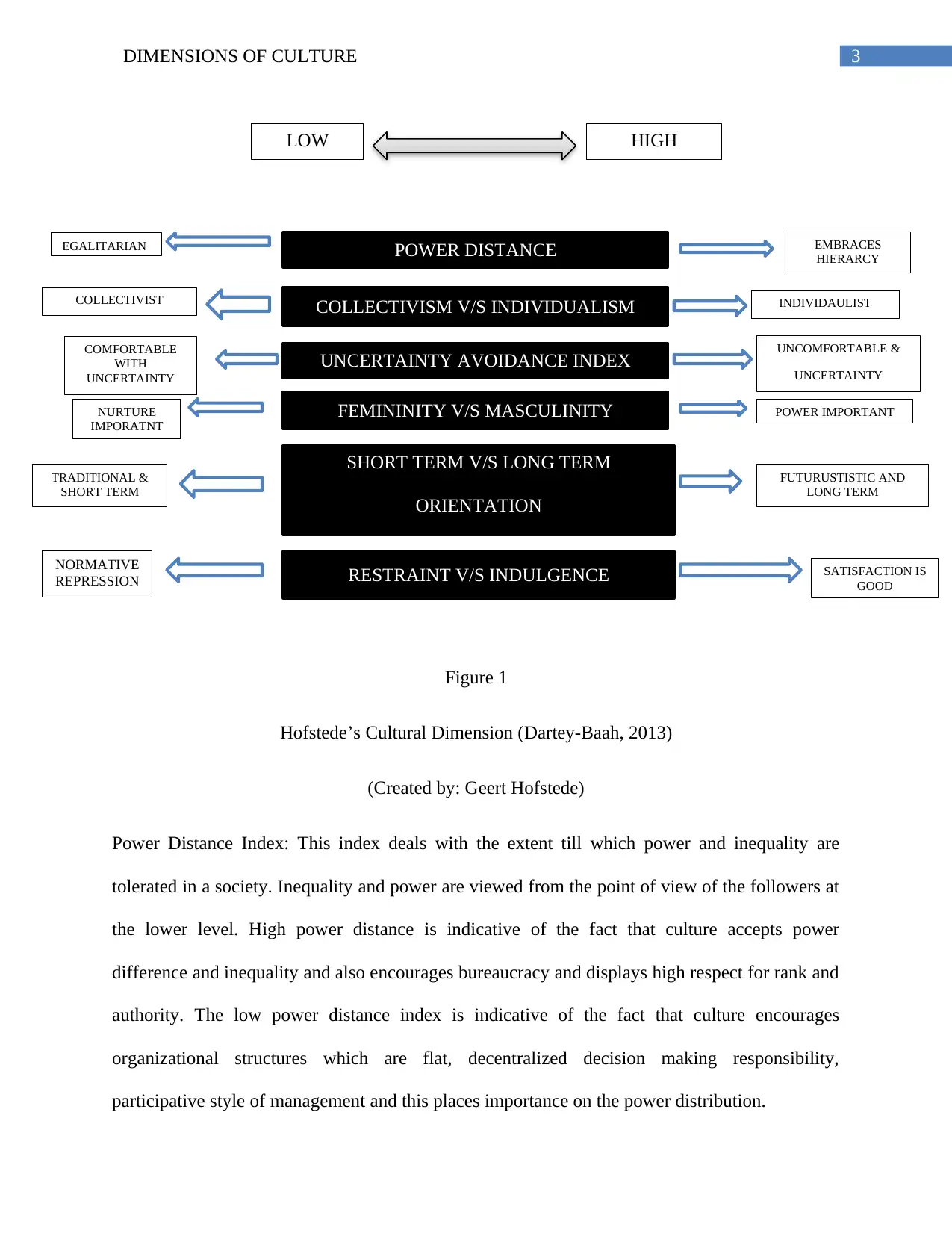
3DIMENSIONS OF CULTURE
Figure 1
Hofstede’s Cultural Dimension (Dartey-Baah, 2013)
(Created by: Geert Hofstede)
Power Distance Index: This index deals with the extent till which power and inequality are
tolerated in a society. Inequality and power are viewed from the point of view of the followers at
the lower level. High power distance is indicative of the fact that culture accepts power
difference and inequality and also encourages bureaucracy and displays high respect for rank and
authority. The low power distance index is indicative of the fact that culture encourages
organizational structures which are flat, decentralized decision making responsibility,
participative style of management and this places importance on the power distribution.
POWER DISTANCE
COLLECTIVISM V/S INDIVIDUALISM
UNCERTAINTY AVOIDANCE INDEX
FEMININITY V/S MASCULINITY
SHORT TERM V/S LONG TERM
ORIENTATION
RESTRAINT V/S INDULGENCE
LOW HIGH
EGALITARIAN EMBRACES
HIERARCY
NORMATIVE
REPRESSION SATISFACTION IS
GOOD
FUTURUSTISTIC AND
LONG TERM
POWER IMPORTANT
UNCOMFORTABLE &
UNCERTAINTY
INDIVIDAULISTCOLLECTIVIST
COMFORTABLE
WITH
UNCERTAINTY
NURTURE
IMPORATNT
TRADITIONAL &
SHORT TERM
Figure 1
Hofstede’s Cultural Dimension (Dartey-Baah, 2013)
(Created by: Geert Hofstede)
Power Distance Index: This index deals with the extent till which power and inequality are
tolerated in a society. Inequality and power are viewed from the point of view of the followers at
the lower level. High power distance is indicative of the fact that culture accepts power
difference and inequality and also encourages bureaucracy and displays high respect for rank and
authority. The low power distance index is indicative of the fact that culture encourages
organizational structures which are flat, decentralized decision making responsibility,
participative style of management and this places importance on the power distribution.
POWER DISTANCE
COLLECTIVISM V/S INDIVIDUALISM
UNCERTAINTY AVOIDANCE INDEX
FEMININITY V/S MASCULINITY
SHORT TERM V/S LONG TERM
ORIENTATION
RESTRAINT V/S INDULGENCE
LOW HIGH
EGALITARIAN EMBRACES
HIERARCY
NORMATIVE
REPRESSION SATISFACTION IS
GOOD
FUTURUSTISTIC AND
LONG TERM
POWER IMPORTANT
UNCOMFORTABLE &
UNCERTAINTY
INDIVIDAULISTCOLLECTIVIST
COMFORTABLE
WITH
UNCERTAINTY
NURTURE
IMPORATNT
TRADITIONAL &
SHORT TERM
Paraphrase This Document
Need a fresh take? Get an instant paraphrase of this document with our AI Paraphraser
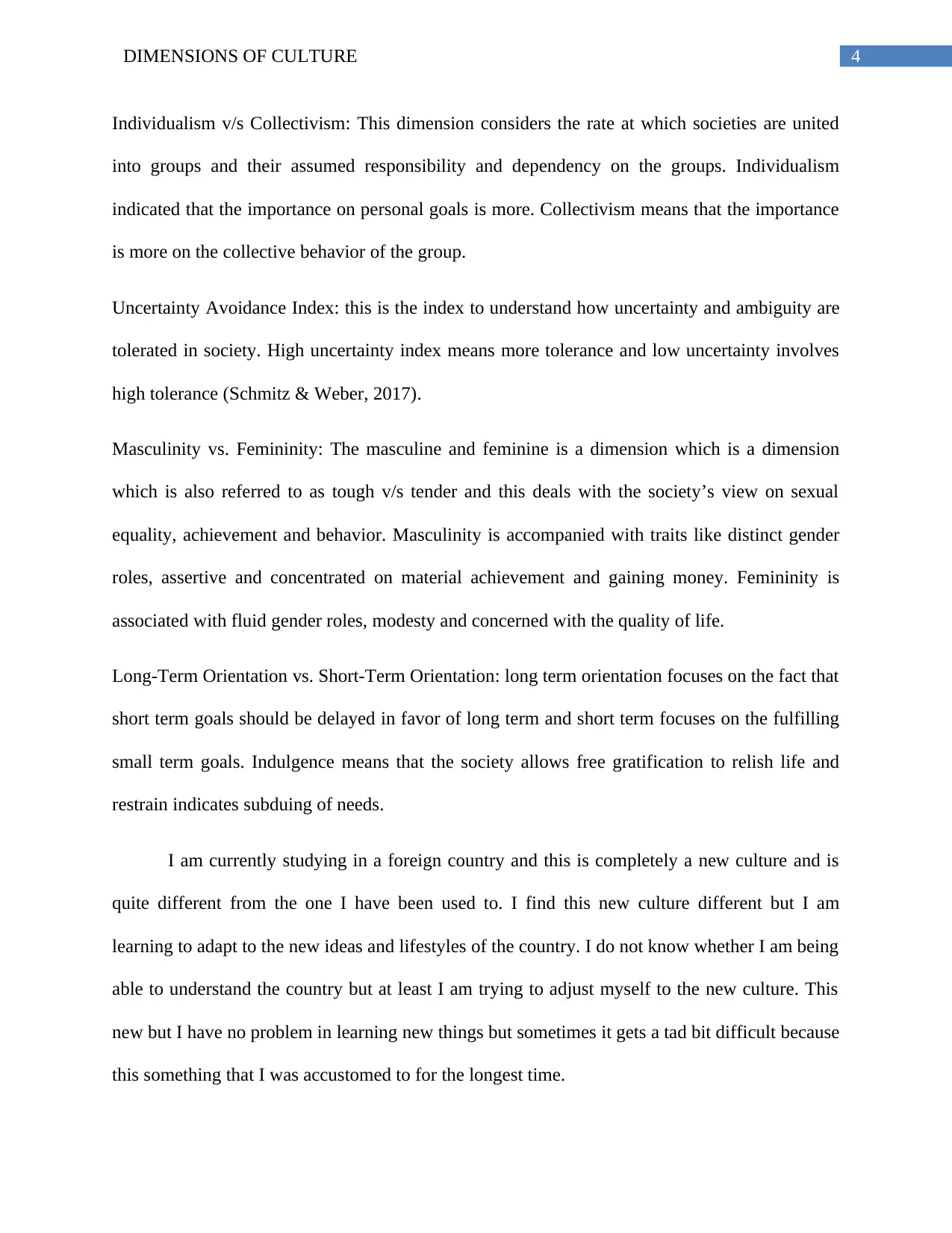
4DIMENSIONS OF CULTURE
Individualism v/s Collectivism: This dimension considers the rate at which societies are united
into groups and their assumed responsibility and dependency on the groups. Individualism
indicated that the importance on personal goals is more. Collectivism means that the importance
is more on the collective behavior of the group.
Uncertainty Avoidance Index: this is the index to understand how uncertainty and ambiguity are
tolerated in society. High uncertainty index means more tolerance and low uncertainty involves
high tolerance (Schmitz & Weber, 2017).
Masculinity vs. Femininity: The masculine and feminine is a dimension which is a dimension
which is also referred to as tough v/s tender and this deals with the society’s view on sexual
equality, achievement and behavior. Masculinity is accompanied with traits like distinct gender
roles, assertive and concentrated on material achievement and gaining money. Femininity is
associated with fluid gender roles, modesty and concerned with the quality of life.
Long-Term Orientation vs. Short-Term Orientation: long term orientation focuses on the fact that
short term goals should be delayed in favor of long term and short term focuses on the fulfilling
small term goals. Indulgence means that the society allows free gratification to relish life and
restrain indicates subduing of needs.
I am currently studying in a foreign country and this is completely a new culture and is
quite different from the one I have been used to. I find this new culture different but I am
learning to adapt to the new ideas and lifestyles of the country. I do not know whether I am being
able to understand the country but at least I am trying to adjust myself to the new culture. This
new but I have no problem in learning new things but sometimes it gets a tad bit difficult because
this something that I was accustomed to for the longest time.
Individualism v/s Collectivism: This dimension considers the rate at which societies are united
into groups and their assumed responsibility and dependency on the groups. Individualism
indicated that the importance on personal goals is more. Collectivism means that the importance
is more on the collective behavior of the group.
Uncertainty Avoidance Index: this is the index to understand how uncertainty and ambiguity are
tolerated in society. High uncertainty index means more tolerance and low uncertainty involves
high tolerance (Schmitz & Weber, 2017).
Masculinity vs. Femininity: The masculine and feminine is a dimension which is a dimension
which is also referred to as tough v/s tender and this deals with the society’s view on sexual
equality, achievement and behavior. Masculinity is accompanied with traits like distinct gender
roles, assertive and concentrated on material achievement and gaining money. Femininity is
associated with fluid gender roles, modesty and concerned with the quality of life.
Long-Term Orientation vs. Short-Term Orientation: long term orientation focuses on the fact that
short term goals should be delayed in favor of long term and short term focuses on the fulfilling
small term goals. Indulgence means that the society allows free gratification to relish life and
restrain indicates subduing of needs.
I am currently studying in a foreign country and this is completely a new culture and is
quite different from the one I have been used to. I find this new culture different but I am
learning to adapt to the new ideas and lifestyles of the country. I do not know whether I am being
able to understand the country but at least I am trying to adjust myself to the new culture. This
new but I have no problem in learning new things but sometimes it gets a tad bit difficult because
this something that I was accustomed to for the longest time.
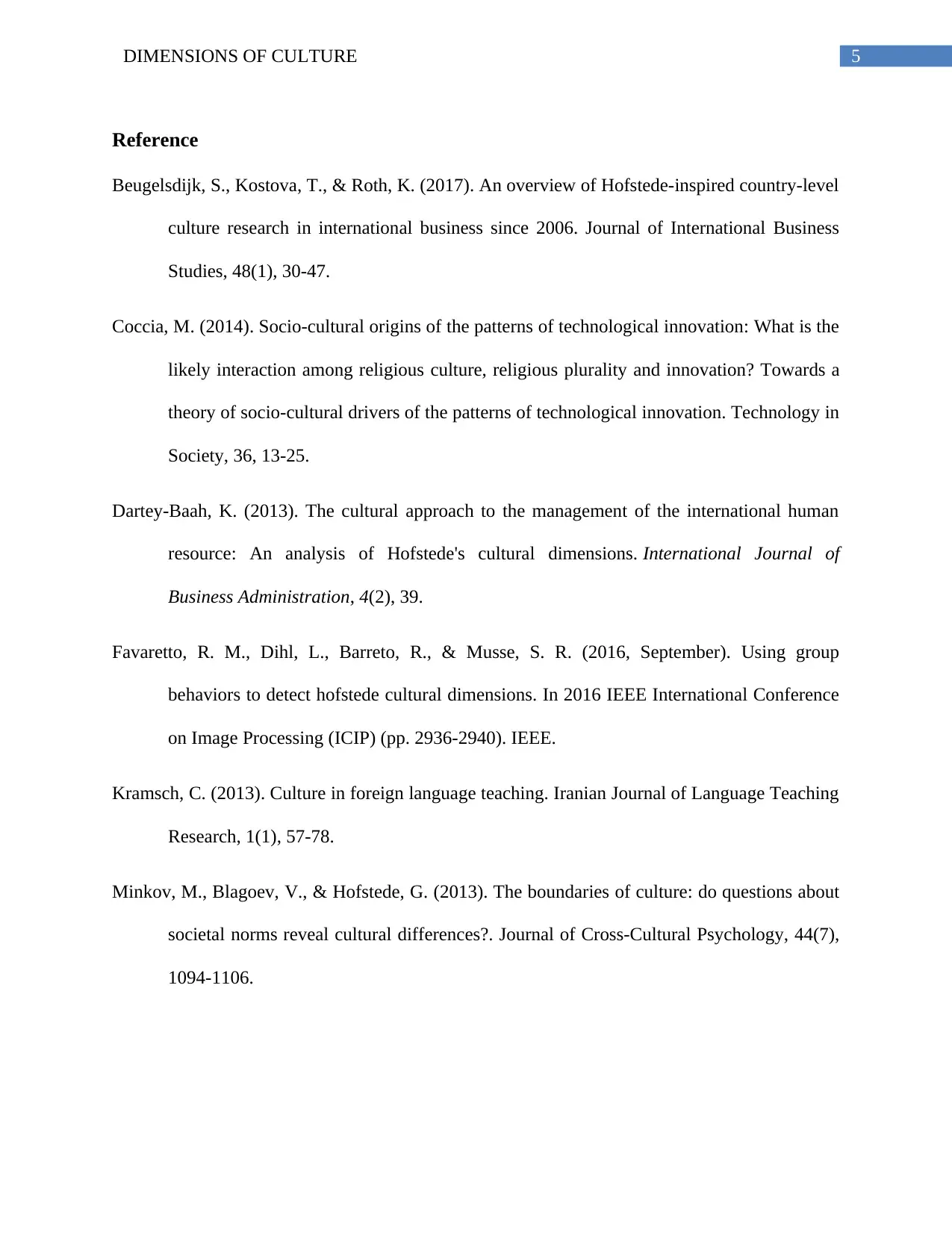
5DIMENSIONS OF CULTURE
Reference
Beugelsdijk, S., Kostova, T., & Roth, K. (2017). An overview of Hofstede-inspired country-level
culture research in international business since 2006. Journal of International Business
Studies, 48(1), 30-47.
Coccia, M. (2014). Socio-cultural origins of the patterns of technological innovation: What is the
likely interaction among religious culture, religious plurality and innovation? Towards a
theory of socio-cultural drivers of the patterns of technological innovation. Technology in
Society, 36, 13-25.
Dartey-Baah, K. (2013). The cultural approach to the management of the international human
resource: An analysis of Hofstede's cultural dimensions. International Journal of
Business Administration, 4(2), 39.
Favaretto, R. M., Dihl, L., Barreto, R., & Musse, S. R. (2016, September). Using group
behaviors to detect hofstede cultural dimensions. In 2016 IEEE International Conference
on Image Processing (ICIP) (pp. 2936-2940). IEEE.
Kramsch, C. (2013). Culture in foreign language teaching. Iranian Journal of Language Teaching
Research, 1(1), 57-78.
Minkov, M., Blagoev, V., & Hofstede, G. (2013). The boundaries of culture: do questions about
societal norms reveal cultural differences?. Journal of Cross-Cultural Psychology, 44(7),
1094-1106.
Reference
Beugelsdijk, S., Kostova, T., & Roth, K. (2017). An overview of Hofstede-inspired country-level
culture research in international business since 2006. Journal of International Business
Studies, 48(1), 30-47.
Coccia, M. (2014). Socio-cultural origins of the patterns of technological innovation: What is the
likely interaction among religious culture, religious plurality and innovation? Towards a
theory of socio-cultural drivers of the patterns of technological innovation. Technology in
Society, 36, 13-25.
Dartey-Baah, K. (2013). The cultural approach to the management of the international human
resource: An analysis of Hofstede's cultural dimensions. International Journal of
Business Administration, 4(2), 39.
Favaretto, R. M., Dihl, L., Barreto, R., & Musse, S. R. (2016, September). Using group
behaviors to detect hofstede cultural dimensions. In 2016 IEEE International Conference
on Image Processing (ICIP) (pp. 2936-2940). IEEE.
Kramsch, C. (2013). Culture in foreign language teaching. Iranian Journal of Language Teaching
Research, 1(1), 57-78.
Minkov, M., Blagoev, V., & Hofstede, G. (2013). The boundaries of culture: do questions about
societal norms reveal cultural differences?. Journal of Cross-Cultural Psychology, 44(7),
1094-1106.
⊘ This is a preview!⊘
Do you want full access?
Subscribe today to unlock all pages.

Trusted by 1+ million students worldwide
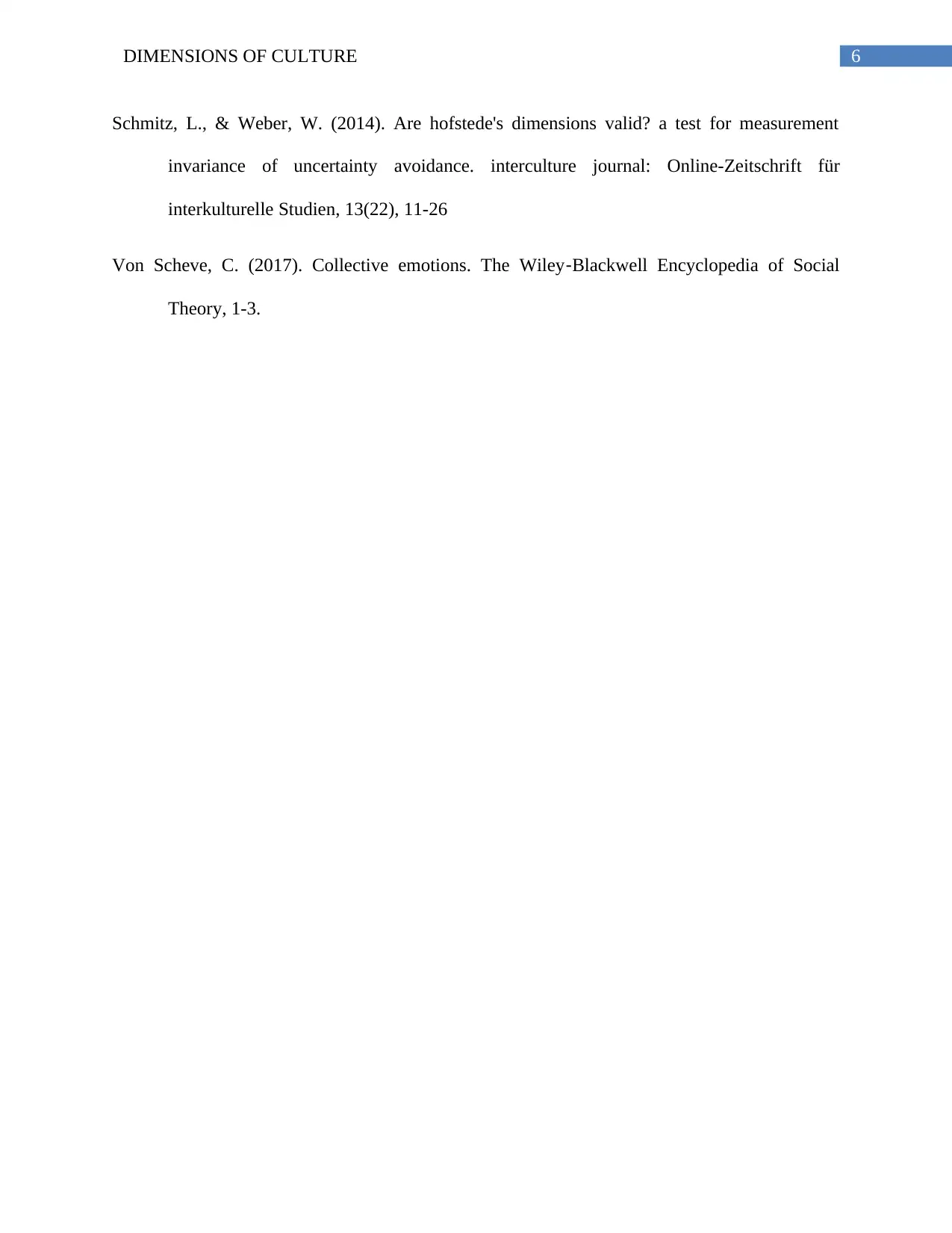
6DIMENSIONS OF CULTURE
Schmitz, L., & Weber, W. (2014). Are hofstede's dimensions valid? a test for measurement
invariance of uncertainty avoidance. interculture journal: Online-Zeitschrift für
interkulturelle Studien, 13(22), 11-26
Von Scheve, C. (2017). Collective emotions. The Wiley‐Blackwell Encyclopedia of Social
Theory, 1-3.
Schmitz, L., & Weber, W. (2014). Are hofstede's dimensions valid? a test for measurement
invariance of uncertainty avoidance. interculture journal: Online-Zeitschrift für
interkulturelle Studien, 13(22), 11-26
Von Scheve, C. (2017). Collective emotions. The Wiley‐Blackwell Encyclopedia of Social
Theory, 1-3.
1 out of 7
Related Documents
Your All-in-One AI-Powered Toolkit for Academic Success.
+13062052269
info@desklib.com
Available 24*7 on WhatsApp / Email
![[object Object]](/_next/static/media/star-bottom.7253800d.svg)
Unlock your academic potential
Copyright © 2020–2025 A2Z Services. All Rights Reserved. Developed and managed by ZUCOL.





